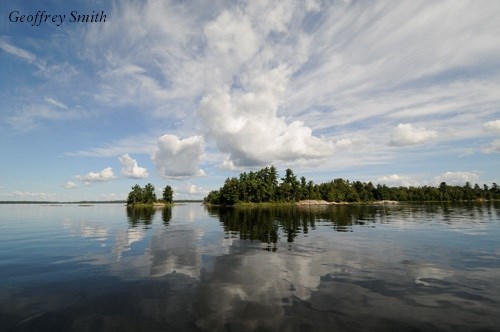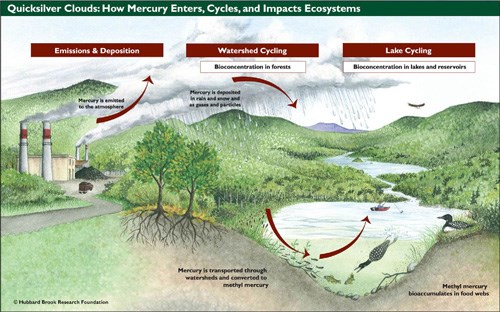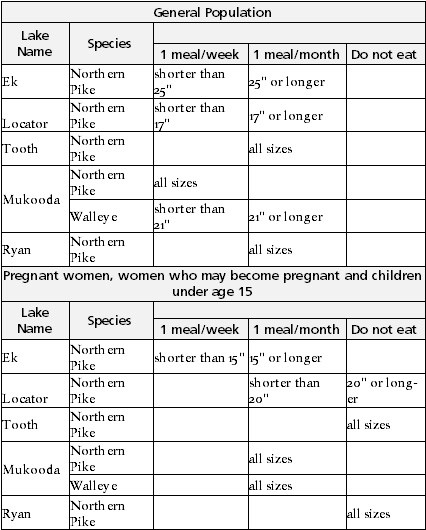
Photo Credit: Geoffrey Smith Background Despite the fact that Voyageurs National Park (Figure 1) exists in a relatively remote setting with no major local source of mercury contamination, all Voyageurs lakes that have been sampled for mercury are listed as impaired by the U.S. Environmental Protection Agency. Mercury contamination in some of these lakes exceeds levels shown to negatively affect the health of fish and wildlife, and fish consumption advisories are necessary in all Voyageurs National Park lakes for protection of human health. Voyageurs National Park exists in a mercury-sensitive landscape; a high proportion of mercury deposited in the watersheds of park lakes is transformed into a toxic and biologically available form, methylmercury. Research shows that the majority of mercury delivered to park lakes is deposited through rainfall and dry deposition and originates from human caused emissions1. The fact that air pollution can cause this level of damage through mercury contamination of fish and wildlife of a fairly remote national park underscores the importance of clean air to aquatic ecosystem health. 
Mercury Contamination- A threat to Voyageurs National Park Ecosystems and Recreational Fishing Human caused mercury emissions from coal fired power plants, industrial boilers, and other sources release mercury into the atmosphere from which it is deposited via rain and dry deposition (Figure 2). Once mercury has entered aquatic systems, it settles into the sediment where a portion of it is taken up and transformed into highly toxic methylmercury by bacteria. Methylmercury bioaccumulates up the food chain, meaning it is found in much higher levels further up the food chain from prey fish, to predatory fish, to fish - eating wildlife. Mercury levels in fish in some Voyageurs National Park lakes are above thresholds shown to impair fish reproductive and neurological health3. Mercury Levels in Voyageurs National Park:

Research Findings All Voyageurs National Park lakes are currently under fish consumption advisories (Figure 3). However, atmospheric deposition of mercury contamination has been declining in some portions of Minnesota since the mid to late 20th century4. This decline is attributed to removal of mercury from products, industrial processes, and waste streams. Trends in atmospheric deposition of mercury, mercury in lake water, and yellow perch mercury contamination were recently assessed in four small lakes in Voyageurs. Consistent with decreased deposition of atmospheric pollutants from 1998-2012 in northern Minnesota, mercury in lake water and mercury in small yellow perch decreased in two of the four sampled lakes5. Other watershed factors may have prevented similar decreases in the other two study lakes. The decrease in deposition means smaller amounts of atmospheric mercury are entering our waterways and contaminating fish and wildlife. Continued reductions in mercury emissions may eventually result in unimpaired aquatic systems and would have a positive effect on the health of fish and wildlife as well as on people who consume fish. Management Implications
References 1Wiener, J.G., Knights, B.C., Sandheinrich, M.B., Jeremiason, J.D., Brigham, M.E., Engstrom, D.R., Woodruff, L.G., Cannon, W.F., and Balogh, S.J. 2006.Mercury in Soils, Lakes, and Fish in Voyageurs National Park (Minnesota): Importance of Atmospheric Deposition and Ecosystem Factors. Environmental Science and Technology. 40: 6261-6268. 2Driscoll, C.T., D. Evers, K.F. Lambert, N. Kamman, T. Holsen, Y-J. Han, C. Chen, W. Goodale, T. Butler, T. Clair, and R. Munson. Mercury Matters: Linking Mercury Science with Public Policy in the Northeastern United States. Hubbard Brook Research Foundation. 2007. Science Links Publication. Vol. 1, no. 3. 3Sandheinrich, M.B., and Wiener, J.G. 2011. Methylmercury in freshwater fish: Recent advances in assessing toxicity of environmentally relevant exposures, in Beyer, W.N., and Meador, J.P.,eds.,Environmental Contaminants in Biota: Interpreting Tissue Concentrations, 2nd edition, Boca Raton, Florida, U.S.A., Taylor and Francis Publishers. 4Engstrom, D.R., Balogh, S.J., Swain, E.B. 2007. History of mercury inputs to Minnesota lakes: Influences of watershed disturbance and localized atmospheric deposition. Limnology and Oceanography. 52:2467-2483. 5Brigham, M.E., Sandheinrich, M.B., Gay, D.A., Maki, R.P., Krabbenhoft, D.P., Wiener J.G. 2014. Lacustrine Response to Decreasing Wet Mercury Deposition Rates - Results from a Case Study in Northern Minnesota. Environmental Science &Technology. 48:6115-6123. |
Last updated: August 23, 2016
